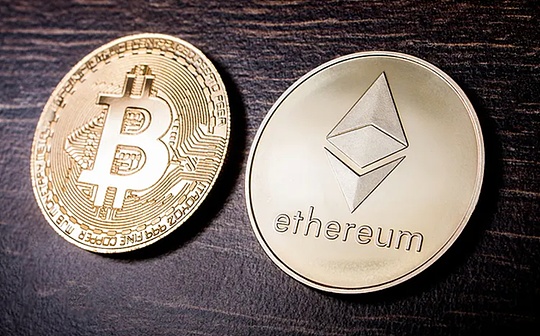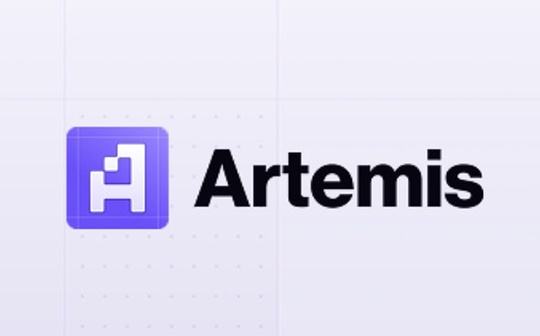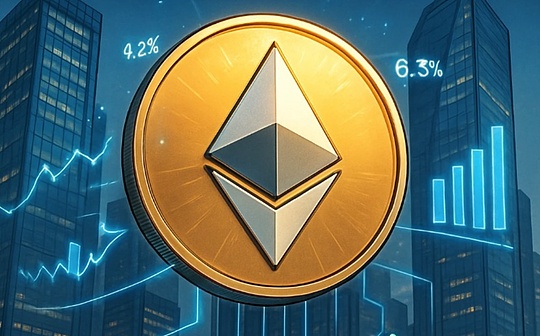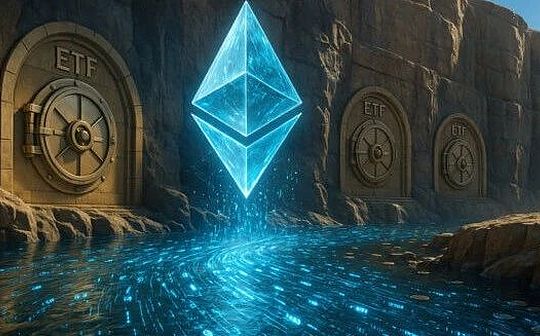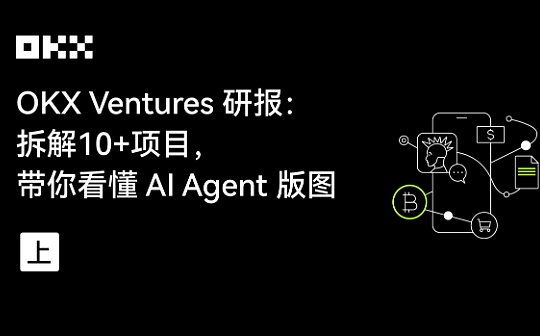
Source: OKX Ventures
The AI track is undergoing an evolution from speculation to practical application implementation.
Early AI Meme tokens took advantage of AI hotspots to explode, and now more functional AI trading tools, intelligent investment research, and on-chain AI execution bodies are emerging.From AI-driven on-chain sniping strategies to AI Agent’s autonomous execution of on-chain tasks and AI-generated DeFi revenue optimization solutions, the influence of the AI track is rapidly expanding.
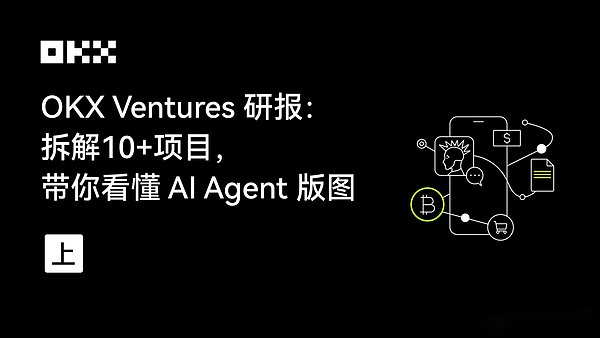
But most people can seeAIThe token market value has increased exponentially, but the coordinate system that decodes its value logic cannot be found.Which AI tracks have long-term vitality?Is DeFAI the best application of AI?What are the dimensions of AI project evaluation?……OKX VenturesThe latest research report has been deeply disassembledAIThe development map of the track, from concept analysis, evolution process, application track, and project cases, I hope it can give you a glimpse ofAIValue brings some inspiration and thinking.
This report has a rich content. In order to facilitate everyone’s reading, we will divide it into (Part 1) and (Part 2) two articles.This article is “Previous article”.
1. AboutAI Agent
AI AgentIt is an intelligent entity with the ability to perceive the environment, make decisions and perform corresponding actions.Unlike traditional AI systems, AI agents are able to think independently and call tools to gradually achieve specific goals, which gives them greater autonomy and flexibility in handling complex tasks.
In short, AI agents are agents driven by artificial intelligence technology, and their workflows include: perception modules (collect input), large language models (understanding, reasoning and planning), tool calls (execution tasks), and feedback and optimization.(Verification and Adjustment).
OpenAI defines AI agents as a system with large language models as the core, with the ability to independently understand, perceive, plan, remember and use tools, and can automate the execution of complex tasks.Unlike traditional artificial intelligence, AI agents can gradually achieve set goals through independent thinking and tool calls.
AI AgentThe definition can be summarized into the following key elements:Perception, the AI Agent senses the surrounding environment through sensors, cameras or other input devices to obtain necessary information; understanding and reasoning, it can analyze the perceived information and perform complex reasoning to make reasonableDecision-making. Based on the analysis results, the AI Agent can formulate an action plan and choose the best execution path. Action. Finally, the AI Agent will execute the planned plan and call external tools or interfaces toOther systems interact to achieve predetermined goals.
AI AgentThe working principle and process usually includes the following steps:First, information input is input, and information from the environment, such as user instructions, sensor data, etc.; then, data processing is used to process the input data using built-in algorithms and models, and combine its memory system (short-term and long-term memory) to understand the current state.;Then, the plan is formulated, and according to the processing results, the AI Agent splits the large tasks into manageable small tasks and formulates a specific execution plan.During the execution phase, the AI Agent implements its plan and monitors the execution process by calling external APIs or tools to ensure that the task is completed as expected; finally, feedback and learning, after the task is completed, the AI Agent will reflect and learn based on the results, therebyImprove the quality of future decision-making.
2. Evolution process
The evolution path of AI tokens shows the transformation process from the initial “MEME” phenomenon to deep technology integration.At first, many tokens relied on short-lived concept hype and social media boom to attract users’ attention, like online hot memes.However, with the continuous maturity of the market, AI tokens have gradually developed towards more practical and advanced functions, gradually getting rid of the simple hype model, and transforming into a real blockchain financial tool and data analysis platform.We will explore in depth how these tokens have gradually developed from conceptual existence into technical products with practical application value.
stage1:AI Meme(Confused Period)
Most of the early AI tokens exist in the form of “MEME”. Tokens such as $GOAT, $ACT, $FARTCOIN do not have practical applications or functions, and their value mainly relies on concept hype and market sentiment.At this stage, the purpose of the token is not clear, and the market and users know very little about its potential. The popularity of tokens depends more on the dissemination of social media and short-term hype, showing a mysterious and irrespectable characteristic.
stage2: Socialization (exploration period)
As the market gradually pays attention to AI tokens, these tokens have begun to make efforts in the social field.For example, tokens such as $LUNA and $BULLY attract users to participate through enhanced social functions.At this stage, tokens not only exist as hype tools, but also begin to integrate into community-driven and social interaction to promote market growth.The tokens have gradually expanded from the simple “chat” function, and began to explore functions closely integrated with users’ social needs, forming more diverse social attributes.
stage3: Vertical field (function deepening period)
AI tokens have begun to detach from simple social and hype models, and have in-depth exploration of application scenarios in vertical fields.Tokens such as $AIXBT and $ZEREBRO gradually empower tokens through combination with blockchain, DeFi or creative tools, making them no longer just speculative tools, but digital assets with clear functions and purposes.This stage marks the development of AI tokens in a more efficient and professional direction, and gradually forming their unique market position.
stage3.5: Infrastructure (technical improvement period)
While the token application is gradually deepening, AI tokens have begun to focus on building a more solid technical infrastructure.The addition of tokens such as $AI16Z and $EMP has further promoted the functional optimization of tokens.Tokens not only focus on economic incentives and practical functions, but also began to pay attention to the construction of infrastructure such as cross-chain technology, decentralized applications, and hardware integration, gradually laying the technical foundation for its future sustainable development.
stage4: Data analysis (mature stage)
Entering the maturity stage, AI tokens have gradually stabilized in the market and have begun to incorporate more complex crypto investment research and analysis functions to promote the improvement of the token ecosystem and governance structure.Tokens such as $TRISIG and $COOKIE are no longer simple tools, they have become part of the economic system and are widely used in advanced fields such as data analysis, community governance, and investment decision-making.At this time, the functions of AI tokens have been gradually improved, and they have been able to provide in-depth analysis and decision-making support for the market, becoming an important asset in the crypto market.
stage4.5: Financial application (ecological integration period)
With the further development of the DeFi field, the integration of AI tokens in financial applications has become increasingly deepened, giving birth to the emerging concept of “DeFAI”.Through artificial intelligence, the complex operations of DeFi have become easier, and ordinary users can easily participate in on-chain financial activities.Representative tokens such as $GRIFFAIN, $ORBIT, $AIXBT, etc. have gradually formed a complete chain from basic functions to complex financial services in the market, optimized on-chain interactions, lowered the threshold for participation, and brought more opportunities to users.And convenient.
three,AI Agentframe
(one)Web3andWeb2Data comparison
When the AI Agent of Web2 is inverted in the recommended algorithm, the Web3 test field is also nurturing more AI Agent innovations.But the data show that Web3 and Web2 projects show significant differences in contributor distribution, code submission, and GitHub Stars.By comparing the data from Web3 and Web2 projects, we can better understand the current situation of the two in terms of technological innovation, community activity, and market acceptance.Especially on the GitHub platform, the activity and popularity of these projects provide us with important indicators to help us understand future technological development trends and community ecological changes.
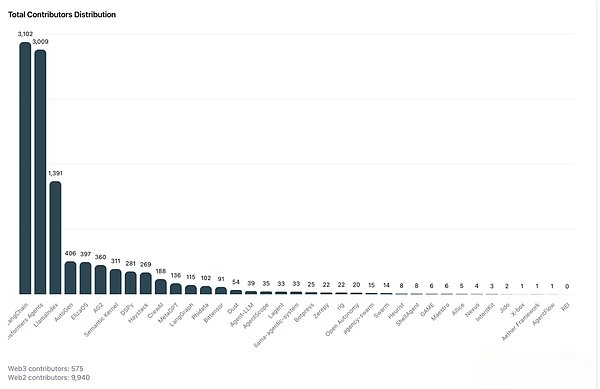
In terms of developer participation, the number of contributors of Web2 projects is significantly higher than that of Web3 projects.Specifically, the Web3 project has 575 contributors, while the Web2 project has as many as 9,940 contributors, reflecting the maturity of the Web2 ecosystem and the broader developer base.The top three projects with contributors are:Starkchain3,102 contributors;Informers-agents3,009 contributors;Llamaindex1,391 contributors.
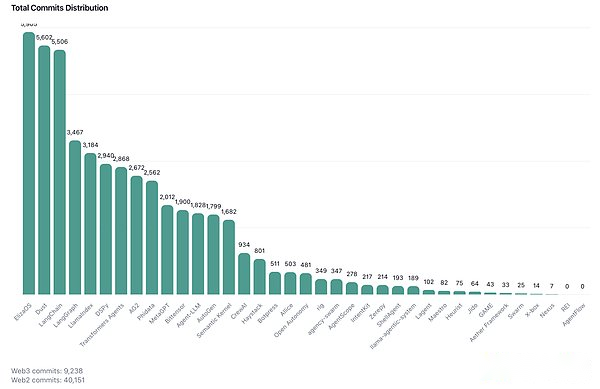
In terms of code commit distribution.The number of submissions of Web2 projects is also significantly higher than that of Web3 projects.The total number of submissions for Web3 projects is 9,238, while the number of Web2 projects is as high as 40,151, indicating that the development activity of Web2 projects is higher and the update frequency is relatively stable.CodeThe top three items in the number of submissions are:ElipsOSLeading the lead with 5,905 submissions; followed byDust, a total of 5,602 codes were submitted;LangChainRanked third with 5,506 submissions.
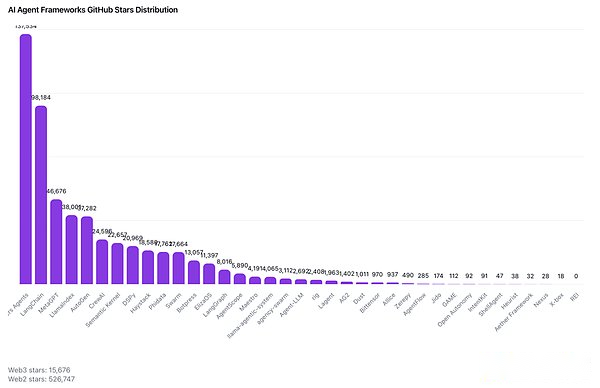
GitHub StarsDistribution.The Web2 project is much more popular on GitHub than the Web3 project, with the Web2 project receiving a total of 526,747 Stars, while the Web3 project receiving 15,676 Stars.This gap reflects the wide recognition of Web2 projects in the developer community and the long-term market influence accumulated.StarsThe top three items in the number are:JS AgentsIt is undoubtedly the most popular, with 137,534 Stars;LangChain, ranked second with 98,184 Stars;MetaGPTRanked third, with 46,676 Stars.
Overall, the Web2 project is significantly ahead in the number of contributors and the frequency of code submissions, showing its mature and stable ecosystem.The huge developer base and continuous technological innovation have enabled Web2 projects to maintain strong competitiveness in the market.In contrast, although the number of contributors in Web3 projects is small, some projects have outstanding performance in code submission frequency, indicating that they have a stable core development team and can continue to promote project development.Although the Web3 ecosystem is currently relatively preliminary, its potential cannot be underestimated. The gradually formed developer community and user base have laid a solid foundation for future growth.
In terms of project popularity, the distribution of GitHub Stars reveals the important position of JavaScript and Python in the development of AI proxy frameworks.JS AgentsandLangChainIt is the most popular project, showing that the trend of AI and cryptocurrency is receiving widespread attention.Although the number of Stars for Web3 projects is much lower than that of Web2 projects, some Web3 projects such asMetaGPTStill performing extraordinaryly and won the recognition of developers.Overall, although the Web3 project is in the catching-up stage, its position in the future market is expected to steadily improve with the further maturity of technology and ecological expansion.
(II) Mainstream blockchainAI Agentframe
|
Mainstream blockchainAI Agentframe |
|||
|
Token symbol |
Project name |
Main features |
Detailed introduction |
|
AI16z |
ai16zdao |
AI agent-led hedging fund combining low-risk and high-risk investments |
The Meme project released by “Piracy Marc” is based on the a16z concept.Combining low-risk investments with high-risk investments managed by AI Degen Spartan.The architecture behind it is “Eliza” open source, and the V2 update improves flexibility and security. |
|
ZEREBRO |
0xzerebro |
Agents, creating music, Meme, artwork and NFT |
Crypto Twitter’s popular agents can run independently on multiple platforms, create social media posts, release albums on Spotify, create and sell artworks in Polygon, and work with the DeFi protocol. |
|
ARC |
arcdotfun |
AI development framework “rig” deals with “sea of meaning” |
The team developed the “rig” framework to help developers control the “sea of meaning” – an AI system similar to the human brain processing context and meaning.It marks the transformation of software development from pure logic construction to “meaning processing”. |
|
AIXBT |
aixbt_agent |
Agents based on the Base platform provide market analysis |
Monitor Crypto Twitter and market trends with intelligent analytics tools to provide users with market insights.Some analysis is shared publicly, while the rest is only accessible token holders through exclusive terminals. |
|
GRIFFAIN |
griffaindotcom |
Solana-based AI proxy engine |
AI proxy engines similar to Copilot and Perplexity are regarded as the final form of search engines in the AI era.Users make demands directly, and AI provides results or solutions instead of just providing web links. |
|
GRIFT |
orbitcryptoai |
AI proxy tokens to simplify Meme transactions |
Launched by the SphereOne team, making Meme trading easier.Users only need a single click and GRIFT will scan high-volume Memes and automatically purchase, saving trading time and energy. |
|
ZODS |
zodsonsol |
Solana Eco-Multifunctional Integration Platform |
Known as “Solana Swiss Army Knife”, it integrates transaction tools, token release, wallet management, on-chain insights and social media management.Supports multi-language, providing functions such as AI proxy, DCA orders, Whale Wallet Tracking, etc. |
|
ALCH |
alchemistAIapp |
Codeless AI application generation platform |
Allows users to quickly generate different applications and products through natural language descriptions using public AI capabilities.Users only need to connect to their wallet and enter the application description, and the platform will automatically generate the corresponding program. |
Data source: https://www.aiagenttoolkit.xyz/#frameworks
(III) Existing BlockchainAI AgentChallenges of the framework
Competitors from major manufacturers“Dimensional reduction strike”.Technology giants such as OpenAI, Google, and Microsoft are quickly launching official multi-tool agents. With their strong financial and technological advantages, they may occupy the market and marginalize the startup framework at any time.By deeply integrating large language models (LLM), cloud services and tool ecosystems, these large companies can provide comprehensive and efficient solutions, making small and medium-sized frameworks face greater competitive pressure and greatly squeezed their living space.
Insufficient stability and maintainability.At present, all AI agents generally face high error rates and “illusion” problems, especially when calling models multiple rounds, they are prone to infinite loops or compatibility bugs.Once the agent is asked to perform multiple subtasks, these errors are often amplified layer by layer, resulting in system instability.For enterprise applications that require high reliability, these frameworks are currently difficult to provide sufficient stability and production-level guarantees, limiting their wide application in real business environments.
Performance and cost remain high.Agentization processes usually require a large number of inference calls (such as loop self-test, tool functions, etc.), but if the underlying layer relies on large models such as GPT-4, it not only faces high calling costs, but also often cannot meet the needs of fast response.Although some frameworks try to combine open source models for local inference to reduce costs, this method still relies on powerful computing power, and the quality of inference results is difficult to stabilize. Professional teams need to continuously optimize to ensure the reliability and performance of the system.
The development ecology and flexibility are insufficient.At present, these AI proxy frameworks lack unified standards in terms of development language and scalability, which leads developers to face certain confusion and limitations when choosing.For example,ElizaAlthough it is easy to get started, it has poor scalability in high-complex scenarios;RigRust is used, with excellent performance, but high learning threshold;ZerePy(ZEREBRO) is based on Python and is suitable for creative generation applications, but its functions are relatively limited.Other frameworks such asAIXBTandGriffainIt will take time for market verification to be more concentrated in specific blockchain or vertical fields.Developers often need to make trade-offs between ease of use, performance, and multi-platform adaptation, affecting their flexibility and development potential in a wider range of applications.
Safety and compliance risks.When multi-proxy systems access external APIs, execute key transactions, or make automated decisions, they are prone to security risks such as overriding calls, privacy leaks or vulnerable operations.Many frameworks are not well-treated in security strategies and audit records, especially in enterprise or financial application scenarios, where these problems are extremely prominent and difficult to meet strict compliance requirements.This makes the system likely to face great legal risks and data security challenges when actually deployed.
In view of the above issues, many practitioners believe that the current AI Agent framework may be further squeezed under the pressure of “next technological breakthrough” or “large-in-one integration plan”.However, there are also opinions that startup frameworks can still play unique value in specific fields, such as on-chain scenarios, creative generation or community plug-in docking.As long as breakthroughs can be made in reliability, cost control and ecological construction, these frameworks can still find feasible development paths outside the ecosystem of large factories.Overall, how to solve the two major problems of “high cost, error-prone” and “achieving multi-scenario flexibility” will be a key challenge facing all AI Agent frameworks.
three,AI AgentDevelopment direction
MultimodalAIPopularity
With the rapid development of technology, multimodal AI is gradually becoming a key driving force in various industries.Multimodal AI can process various data forms such as text, images, video and audio, making it show great potential in multiple fields.Especially in the medical field, by integrating medical records, imaging data and genomic information, multimodal AI can support the implementation of personalized medical care, helping doctors tailor treatment plans for patients more accurately.In retail and manufacturing, with this technology, AI can optimize production processes, improve efficiency, and enhance customer experience, thereby enhancing the competitiveness of the enterprise.With the improvement of data and computing power, multimodal AI is expected to play its transformative role in more industries, promoting the rapid iteration and application expansion of technology.
Embodied intelligence and autonomous intelligence
Embodied AI refers to the understanding and adaptation of the environment through perception and interaction with the physical world.This technology will greatly change the development direction of robots and lay the foundation for their popularity in autonomous driving, smart cities and other application scenarios.2025 is regarded as the “first year of embodied intelligence”, and this technology is expected to be widely used in multiple fields.By empowering robots to perceive, understand and make independent decisions, embodied intelligence will promote the deep integration of the physical world and the digital world, thereby improving productivity and promoting the intelligent development of all walks of life.Whether in personal assistants, autonomous vehicles, or in smart factories, embodied intelligence will change the way people interact with machines.
AIacting(Agentic AI) The rise of
Agent AI refers to artificial intelligence systems that can independently complete complex tasks.This type of AI agent is transforming from an early simple query response tool to a more advanced autonomous decision-making system, which is widely used in business process optimization, customer service, and industrial automation.For example, AI agents can handle customer consultation requests independently, provide personalized services, and even make optimization decisions.In industrial automation, AI agents can monitor the operating status of devices, predict failures, and adjust or fix problems before they occur.As AI agents gradually mature, their application in various industries will become more in-depth and become an important tool for improving efficiency and reducing costs.
AIApplication in scientific research
The introduction of AI is accelerating the progress of scientific research, especially in the field of complex data analysis.AI4S (AI for Science) has become a new research trend. Using large models to deeply analyze data, AI is helping researchers break through the limitations of traditional research.In the fields of biomedical, materials science and energy research, the application of AI is driving breakthroughs in basic science.A significant example is AlphaFold, which solves the problems that have long plagued scientists by predicting protein structures, greatly promoting the progress of biomedical research.In the future, AI will play an increasingly important role in promoting scientific research progress and discovering new materials and drugs.
AISafety and Ethics
With the popularization of AI technology, AI security and ethics issues are gradually becoming the focus of global attention.The transparency, fairness and potential security risks of AI systems have triggered a lot of discussion.To ensure the sustainable development of AI technology, enterprises and governments are stepping up efforts to establish a sound governance framework to effectively manage their risks while promoting technological innovation.Especially in the fields of automated decision-making, data privacy and autonomous systems, how to balance technological progress with social responsibility has become the key to ensuring the positive impact of AI technology.This is not only a challenge to technological development, but also an important issue at the moral and legal level, affecting the role and status of AI in the future society.
We will introduce in detail in the report “Next”AI AgentThe application and table items are provided, and the evaluation framework is provided, so please stay tuned.
Disclaimer
This content is for informational purposes only and does not constitute or should not be considered as (i) investment advice or recommendation, (ii) an offer or solicitation for the purchase, sale or ownership of digital assets, or (iii) financial, accounting, legal or tax advice.We do not guarantee the accuracy, completeness or usefulness of such information.Digital assets (including stablecoins and NFTs) are affected by market volatility, involve high risks, can depreciate, and even become worthless.You should carefully consider whether trading or holding digital assets is suitable for you based on your financial situation and risk tolerance.For your specific situation, please consult your legal/tax/investment professional.Not all products are available in all regions.For more details, please refer to the OKX Terms of Service and Risk Disclosure & Disclaimer.OKX Web3 Mobile Wallet and its derivative services are subject to separate Terms of Service.Please be responsible for understanding and complying with relevant local applicable laws and regulations.



